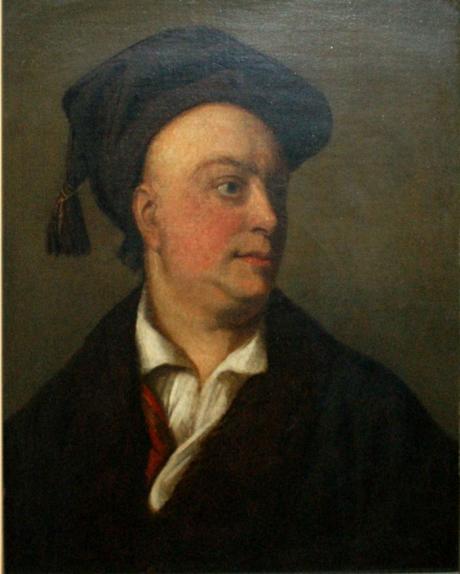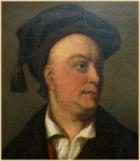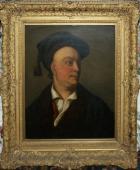inscribed in sepia ink on a label attached to the stretcher ; " Wm Aikman Pinxit/Thomson. (The Poet)/ a greta friend of the/ Painters. Bought at/Derby 1874"
Lord Hamilton, Fife, Scotland
James Thomson (c. 11 September 1700 – 27 August 1748) was a British poet and playwright, known for his poems The Seasons and The Castle of Indolence, and for the lyrics of "Rule, Britannia!".
James Thomson was born in Ednam in Roxburghshire around 11 September 1700 and baptised on 15 September. He was the fourth of nine children of Thomas Thomson and Beatrix Thomson (née Trotter). Beatrix Thomson was born in Fogo, Berwickshire and was a distant relation of the house of Hume. Thomas Thomson was the Presbyterian minister of Ednam until eight weeks after Thomson's birth, when he was admitted as minister of Southdean, where Thomson spent most of his early years.
Thomson may have attended the parish school of Southdean before going to the grammar school in Jedburgh in 1712. He failed to distinguish himself there. Shiels, his earliest biographer, writes: 'far from appearing to possess a sprightly genius, Thomson was considered by his schoolmaster, and those which directed his education, as being really without a common share of parts'. He was, however, encouraged to write poetry by Robert Riccaltoun (1691–1769), a farmer, poet and Presbyterian minister; and Sir William Bennet (d. 1729), a whig laird who was a patron of Allan Ramsay. While some early poems by Thomson survive, he burned most of them on New Year's Day each year.[6]
Thomson entered the College of Edinburgh in autumn 1715, destined for the Presbyterian ministry. At Edinburgh he studied metaphysics, Logic, Ethics, Greek, Latin and Natural Philosophy. He completed his arts course in 1719 but chose not to graduate, instead entering Divinity Hall to become a minister. In 1716 Thomas Thomson died, with local legend saying that he was killed whilst performing an exorcism. At Edinburgh Thomson became a member of the Grotesque Club, a literary group, and he met his lifelong friend David Mallet. After the successful publication of some of his poems in the "Edinburgh Miscellany" Thomson followed Mallet to London in February 1725 in an effort to publish his verse.
In London, Thomson became a tutor to the son of Charles Hamilton, Lord Binning, through connections on his mother's side of the family. Through David Mallet, by 1724 a published poet, Thomson met the great English poets of the day including Richard Savage, Aaron Hill and Alexander Pope. Thomson's mother died on 12 May 1725, around the time of his writing ‘Winter’, the first poem of ‘‘The Seasons’’. ‘Winter’ was first published in 1726 by John Millian, with a second edition being released (with revisions, additions and a preface) later the same year.
By 1727, Thomson was working on Summer, published in February, and was working at Watt's Academy, a school for young gentlemen and a bastion of Newtonian science. In the same year Millian published a poem by Thomson titled ‘A Poem to the Memory of Sir Isaac Newton’ (who had died in March). Leaving Watt's academy, Thomson hoped to earn a living through his poetry, helped by his acquiring several wealthy patrons including Thomas Rundle, the countess of Hertford and Charles Talbot, 1st Baron Talbot.
He wrote Spring in 1728 and finally Autumn in 1730, when the set of four was published together as The Seasons. During this period he also wrote other poems, such as to the Memory of Sir Isaac Newton, and his first play, Sophonisba (1730). The latter is best known today for its mention in Samuel Johnson's Lives of the English Poets, where Johnson records that one 'feeble' line of the poem – "O, Sophonisba, Sophonisba, O!" was parodied by the wags of the theatre as, "O, Jemmy Thomson, Jemmy Thomson, O!".
In 1730, he became tutor to the son of Sir Charles Talbot, then Solicitor-General, and spent nearly two years in the company of the young man on a tour of Europe. On his return Talbot arranged for him to become a secretary in chancery, which gave him financial security until Talbot's death in 1737. Meanwhile, there appeared his next major work, Liberty (1734). This is a lengthy monologue by the "Goddess of Liberty", describing her travels through the ancient world, and then English and British history, before the resolution of the Glorious Revolution of 1688. In 1738 his tragedy Agamemnon was played at Drury Lane and the following year he wrote a prologue when Mallet's Mustapha was performed there.
In 1740, he collaborated with Mallet on the masque Alfred which was first performed at Cliveden, the country home of Frederick, Prince of Wales. Thomson's words for "Rule Britannia", written as part of that masque and set to music by Thomas Arne, became one of the best-known British patriotic songs – quite apart from the masque which is now virtually forgotten. The Prince gave him a pension of £100 per annum. He had also introduced him to George Lyttelton, who became his friend and patron.
In later years, Thomson lived in Richmond upon Thames, and it was there that he wrote his final work The Castle of Indolence, which was published just before his untimely death on 27 August 1748. Johnson writes about Thomson's death, "by taking cold on the water between London and Kew, he caught a disorder, which, with some careless exasperation, ended in a fever that put end to his life". He is buried in St. Mary Magdalene church in Richmond.
A dispute over the publishing rights to one of his works, The Seasons, gave rise to two important legal decisions (Millar v. Taylor; Donaldson v. Beckett) in the history of copyright.
Thomson's The Seasons was translated into German by Barthold Heinrich Brockes (1745). This translation formed the basis for a work with the same title by Gottfried van Swieten, which became the libretto for Haydn's oratorio The Seasons.
Thomson is one of the sixteen Scottish poets and writers appearing on the Scott Monument on Princes Street in Edinburgh. He appears on the right side of the east face.
Thomson has a large memorial in Westminster Abbey's Poets' Corner, next to William Shakespeare and underneath Thomson's countryman, Robert Burns.
Thomson is the poet memorialised at Poets' Corner in Richmond Park's Pembroke Lodge Gardens. A bench sculpted by Richard Farrington, and known as "Poet's seat", is inscribed with lines by Thomson, who was living in Richmond at the time of his death. A wooden memorial plaque with an ode to Thomson by the writer and historian John Heneage Jesse was installed in 1851. The plaque was replaced by the Selborne Society in 1895 and by a re-gilded board in 2014.
King Henry's Mound, which is also in Richmond Park, has a seat inscribed with a few lines from Thomson's poem "The Seasons".
Poetry Editions :
The frontispiece of The Seasons by James Thomson. Published by Alexander Donaldson.
The four seasons, and other poems. By James Thomson. London: printed for J. Millan, near Scotland-Yard, White-Hall; and A. Millar, in the Strand, M.DCC.XXXV., 1735. ;77,;64;72;79,[1]p., plates; 8⁰. (ESTC T83; Foxon T242; OTA K019862.000)
Patrick Murdoch (ed.), The Works of James Thomson, with his last corrections and improvements, prefixed by an account of his life and writings (Royal Quarto edition, A. Millar, London 1762); Dublin printing by John Exshaw, 1767; Murdoch's revised 4-volume edition of (A. Millar and T. Cadell, London 1768), with Lord Lyttelton's annotations, and 1772-3 edition (R. Clarke, Edinburgh 1772), (W. Bowyer, etc., London 1773) and subsequent versions.
Thomson, James & Bloomfield, Robert, The Seasons & Castles of Indolence / The Farmer's Boy, Rural Tales, Banks of the Wye, &c. &c., (London: Scott, Webster & Geary, 1842).
Gilfillan, Rev. George, Thomson's Poetical Works, with Life, Critical Dissertation, and Explanatory Notes, Library Edition of the British Poets (1854).
Thomson, James. The Seasons (A. Donaldson, Edinburgh 1774; J. Donaldson, London 1776).
Thomson, James. The Seasons, by ... A New Edition. Adorned with A Set of Engravings, from Original Paintings. Together with an Original Life of the Author, and a Critical Essay on the Seasons. by Robert Heron, (Perth: R. Morison, 1793).
Thomson, James The Seasons and Castle of Indolence Printed for J. and F.C. Rivington and the other proprietors, James Marsh, 1820
Thomson, James. Poems, edited by William Bayne, London : Walter Scott Publishing Co., [1900], (Series: The Canterbury poets).
Thomson, James. The Seasons, edited with introduction and commentary by James Sambrook, (Oxford: Clarendon Press, 1981) ISBN 0-19-812713-8.
Thomson, James. Liberty, The Castle of Indolence and other poems, edited with introduction and commentary by James Sambrook, (Oxford: Clarendon Press, 1986) ISBN 0-19-812759-6.
Bayne, William, Life of James Thomson, Edinburgh: Oliphant, Anderson and Ferrier, 1898, ("Famous Scots Series").
|
|
William Aikman (24 October 1682 – 7 June 1731) was a Scottish portraitist.
Life and career
Aikman was the son of William Aikman, of Cairney. His father intended that he should follow the law, and gave him an education suitable to these views; but the strong predilection of the son to the fine arts induced him to attach himself to painting alone. Poetry, painting, and music have, with justice, been called sister arts. Mr. Aikman was fond of poetry; and was particularly delighted with those unforced strains which, proceeding from the heart, are calculated to touch the congenial feelings of sympathetic minds. It was this propensity that attached him so warmly to Allan Ramsay, the Doric bard of Scotland. Though younger than Ramsay, Mr. Aikman, while at college, formed an intimate acquaintance with him, which constituted a principal part of his happiness at that time, and of which he always bore the tenderest recollection. It was the same delicate bias of mind which at a future period of his life attached him so warmly to Thomson, who then unknown, and unprotected, stood in need of, and obtained the warmest patronage of Aikman; who perhaps considered it as one of the most fortunate occurrences in his life that he had it in his power to introduce this young poet of nature to Sir Robert Walpole, who wished to be reckoned the patron of genius, and to Arbuthnot, Swift, Pope, Gay, and the other beaux esprits of that brilliant period. Thomson could never forget this kindness; and when he had the misfortune, too soon, to lose this warm friend and kind protector, he bewailed the loss in strains distinguished by justness of thought, and genuine pathos of expression.

Mr. Aikman, having pursued his studies for some time in Britain, found that to complete them it would be necessary to go into Italy, to form his taste on the fine models of antiquity, which there alone can be found in abundance. And as he perceived that the profession he was to follow, could not permit him to manage properly his paternal estate, situated in a remote place near Arbroath-in the county of Forfar in Scotland, he thought proper to sell it, and settle all family claims upon him, that he might be at full liberty to pursue his studies. In 1707, he went to Italy, and having resided chiefly at Rome for three years, and taken instructions from, and formed an acquaintance with the principal artists of that period, he chose to gratify his curiosity by travelling into Turkey. He went first to Istanbul (then known as Constantinople), and from thence to Smyrna. There he became acquainted with all the British gentlemen of the factory; who wished him to forsake the pencil, and to join them in the Turkey trade: but, that scheme not taking place, he went once more to Rome, and pursued his former studies there, till 1712, when he returned to his native country: he now followed his profession of painting for sometime, applauded by the discerning few; though the public, too poor at that period to be able to purchase valuable pictures, were unable to give adequate encouragement to his superior merit John Duke of Argyll, who equally admired the artist and esteemed the man, regretting that such talents should be lost, at length prevailed on Mr. Aikman to move with all his family to London, in 1723, thinking this the only theatre in Britain where his talents could be properly displayed. Under the auspices of this nobleman, he formed habits of intimacy with the first artists, particularly with Sir Godfrey Kneller, whose studies and dispositions of mind were very congenial to his own.
In this society he soon became known to and patronized by people of the first rank, and was in names or intimacy with many of them; particularly the Earl of Burlington, so well known for his taste in the fine arts, especially architecture. For him he painted, among others, a large picture of the royal family of England: in the middle compartment are all the younger branches of the family on a very large canvas, and on one hand above the door a half length of her majesty Queen Caroline; the picture of the king was intended to fill the niche opposite to it, but Mr. Aikman's death happening before it was begun, the place for it is left blank. This picture came into the possession of the Duke of Devonshire, whose father married Lady Mary Boyle, daughter and only child to the Earl of Burlington.
Towards the close of his life, he painted many other pictures of people of the first rank and fashion in England. At Blickling in Norfolk, the seat of Hobart Earl of Buckinghamshire, are a great many full-length pictures by Mr. Aikman; of noblemen, gentlemen, and ladies, relations and friends of the earl. These, with the royal family above named, were his last works; and but a few of the number he painted in London. He died on 7 June 1731.
Art

In his style of painting, Mr. Aikman seems to have aimed at imitating nature in her pleasing simplicity: his lights are soft, his shades mellow, and his colouring mild and harmonious. His touches have neither the force nor harshness of Rubens; nor does he seem, like Reynolds, ever to have aimed at adorning his portraits with the elegance of adventitious graces. His mind, tranquil and serene, delighted rather to wander with Thomson in the enchanting fields of Tempe, than to burst, with Michelangelo, into the ruder scenes of the terrible and the sublime. His compositions are distinguished by a placid tranquility and ease rather than a striking brilliancy of effect: and his portraits may be more readily mistaken for those of Kneller than any other eminent artist; not only because of the general resemblance in the dresses, which were those of the times, they being contemporaries, but also for the manner of working, and the similarity and bland mellowness of their tints.
Several portraits painted by Mr. Aikman in Scotland have been in the possession of the Duke of Argyll, the Duke of Hamilton, and others. There has also been a portrait of Aikman in the gallery of the Grand Duke of Tuscany, painted by himself; and another of the same in the possession of his daughter, Mrs. Forbes, in Edinburgh, whose only son represented the family of Aikman.
- This article incorporates text from Chalmers, Alexander. "Aikman, William, The General Biographical Dictionary: Containing an Historical and Critical Account of the Lives and Writings of the most Eminent Persons in Every Nation; Particularly the British and Irish; from the Earliest Accounts to the Present Time". new ed. rev. and enl. London: Nichols [et al.], 1812–1817. 32 vols.
- Chambers, Robert; Thomson, Thomas Napier (1857). . A Biographical Dictionary of Eminent Scotsmen. Vol. 1. Glasgow: Blackie and Son. pp. 38–41 – via Wikisource.
- Macmillan, Duncan (1984), Scottish Painting: Ramsay to Raeburn, in Parker, Geoffrey (ed.), Cencrastus No. 17, Summer 1984, pp. 25 – 29, ISSN 0264-0856External links[edit]





